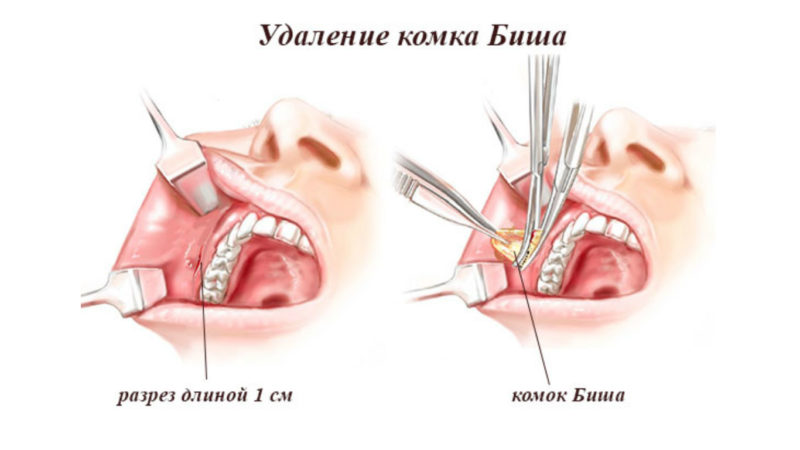Often you can meet people under whose zygomatic bone noticeable seals are quite large. In some cases, they reach the size of a chicken egg. This causes not only psychological discomfort, but also disrupts the function of the facial muscles. Such deposits were called "lumps of Bisha", by the name of the scientist who first distinguished them as a separate anatomical formation. So, Bisha's lumps: what is it, how to treat, what are the consequences of treatment or refusal of medical intervention?
Material Content:
What are lumps of Bisha?
Bisha Fat Lump is an anatomical formation consisting of adipose tissue enclosed in a capsule. It is located on both sides of the face, below the cheekbones, between the buccal and chewing muscles.

Normally present in all people and performs the following functions:
- participation in the act of sucking in infants;
- protection of facial muscles and nerve trunks from mechanical influences;
- reduced friction when chewing food.
All the above functions are implemented by Bisha's lumps in childhood. With the development of facial tissues, the need for fat accumulations disappears. They turn into peculiar rudiments: they do not perform any functions, do not grow together with the surrounding tissues, mechanically change the shape of the face, giving the cheeks a swelling.
Due to the anatomical features of the body, fatty tissues of the face can have a different volume. In some people, lumps are almost invisible, in others they have a significant volume and seriously affect the shape of the face.With age, their sizes decrease slightly, however, at the same time, Bisha's lumps sag with the formation of a pronounced nasolabial triangle and the so-called “bulldog” cheeks. From the foregoing, it became clear what Bisha lumps are. However, why and in what cases are they removed?
Why remove bisha lumps?
Removing lumps of Bisha is almost always done exclusively for aesthetic purposes. The fact is that fat deposits at a young age are often large and give a puffy appearance even to the face of fit and athletic people. With age, the lumps sag, which, as mentioned above, is the cause of the appearance of bulldog cheeks and a general deterioration in appearance.
It is worth noting that the removal of fatty lumps does not always allow achieving the desired result. Quite often, the cause of puffiness lies in the excessive nutrition and anatomical features of a person that are not related to the size of the considered areas of the face. Therefore, before resorting to plastic surgery, you should consult with a specialist and conduct a computer simulation of the results of the desired surgical intervention.
Indications for removal
Indications for the removal of lumps are mainly aesthetic.
The operation is prescribed in cases when:
- lumps are very large, which leads to a significant change in the shape of the face for the worse;
- due to lumps, too much age-related drooping of the cheek tissue occurs;
- lumps - the cause of an excessively pronounced nasolabial fold;
- too round features with a general low body weight;
- the need for rapid movement of a certain amount of adipose tissue during plastic surgery.
It is interesting to know: in the history of medicine there are cases when the procedure for removing lumps was performed according to medical rather than aesthetic indications. The size of body fat in the patient in question exceeded the size of the chicken egg. In this case, the function of the jaw and chewing muscles was impaired. The removal was carried out promptly, during the intervention, the lumps were cut out and the patient acquired the opportunity to eat normally.
Removal Technique
Preparation for an operation to remove fatty clots can take from one to several days. This indicator depends on the capabilities of the clinic and the time needed by the laboratory to carry out the necessary tests.
The preparatory package of measures includes:
- A survey of the patient, during which it is revealed that he has chronic diseases, allergic reactions to a particular drug, a history of life and health. If absolute contraindications for intervention are detected at the stage of the survey, preparation for the surgical removal of Bisha's lumps is stopped.
- Inspection, during which the doctor determines the scope and technique of the upcoming intervention, selects the removal method.
- Computer simulation, at the stage of which the patient is given the opportunity to assess in advance the result of the planned intervention. In some cases, expectations do not correspond to reality, and a person refuses the procedure.
- Laboratory examination. As before any other operation, a patient is sampled for a series of laboratory tests. These include a general blood test, a biochemical blood test, a coagulogram, and a blood contact infection test.
Removal of lumps can be done using a laser or the traditional surgical method.
Laser removal
Removal of Bisch lumps using a surgical laser is a modern, less traumatic method of bisectomy. During the operation, the doctor does not cut out, but rather evaporates fatty tissue by local heating. At the same time, the risk of bleeding is reduced, regenerative processes are stimulated, the skin is tightened to the desired limit.
Technically, the laser version of the procedure is simpler than the traditional surgical one. When carrying out it, the surgeon introduces a cannula about 1 mm thick from the inside of the cheek, through which a probe is mounted in the adipose tissue. The head of the latter is a laser emitter.
Under the influence of radiation, only fat rich in moisture in fat cells is heated and destroyed. Nerve and vascular tissue is not affected. The laser acts selectively. The breakdown products of fats are absorbed into the bloodstream, neutralized by the liver and excreted without causing any harm.
The laser method of bisectomy is good because it allows you to almost immediately see the result of the surgeon's work. In addition, the doctor has the ability to more accurately determine the number of tissues removed with a partial version of the operation (lumps are not always completely removed).
Scalpel application
Traditional operative bisectomy is used when the lumps are large enough. In addition, the operation can be performed as part of other interventions that require a traditional approach (facelift + bisectomy). Depending on the patient's tolerance to anesthetic drugs, the procedure can be performed under general anesthesia or under local anesthesia.

Technically, the intervention is as follows:
- The patient is intubated and injected into anesthesia.
- The surgeon makes a small incision on the inside of the cheek mucosa;
- Through the incision, access to the desired site is provided.
- The doctor grabs the lump with tweezers and removes, gradually cutting the tissue with which it has grown.
- Sanitation of the damaged area and hemostasis in the presence of bleeding are provided.
- The wound is sutured with absorbable thread.
- An antiseptic insulating pad is applied to the wound.
The internal type of online access allows you to make the scar from the operation invisible, and also reduces the recovery period. Due to the bactericidal substances (lysozyme) contained in saliva, the risk of wound infection is practically absent.
Of course, the risks associated with surgery are slightly higher than with laser removal of lumps. The risk of tissue infection, although reduced, does not completely disappear. In addition, the possibility of postoperative bleeding, thrombosis, and suture failure cannot be ruled out.
Recovery period
The duration of the full recovery period after surgical bisectomy is 2-3 months. Only then can the result of the operation be fully evaluated. Laser removal requires slightly shorter recovery time due to less invasiveness of the intervention.
In the first week after the operation, it is forbidden to eat solid foods, chewing which requires tension of the masticatory muscles. It is better if the diet will consist of liquid dishes. After each meal, rinse your mouth with chlorhexidine. In addition, face massage and exposure to high temperature tissues (bath, sauna) should be avoided, as this can cause bleeding. It is necessary to sleep on a high pillow, so that the head is above body level.

For the speedy regeneration and prevention of infectious processes, the surgeon can prescribe a course of antibacterial therapy, regenerative drugs, and microcirculatory aids. As a rule, the course of drug treatment does not exceed 7-10 days. Further, the need for it disappears.
The cost of surgery in Russia
The cost of a bisectomy in Russia varies significantly depending on the region, clinic, method of intervention and type of anesthesia. In “middle arm” clinics on the periphery of the Russian Federation, lumps can be removed surgically under local anesthesia for 20-25 thousand rubles. The cost of laser surgery in fashionable clinics in Moscow and St. Petersburg sometimes reaches 100-120 thousand rubles.
Contraindications for surgery

Among the contraindications for removing lumps of Bisha include:
- patient age less than 25 years;
- mental illness in the acute stage;
- hemophilia and other coagulopathies;
- acute inflammatory diseases in the area of the alleged intervention;
- acute infectious diseases;
- recent operations under general anesthesia;
- unstable body weight (athletes alternating mass-gaining periods with intervals of "drying").
It is worth noting that the contraindications include, and personal reluctance of a person to perform surgery. Sometimes people come to the clinics who do not consider the intervention necessary for themselves, but agree to be removed for the sake of the wishes of relatives, husband, etc. Such customers will be refused.
Possible complications after surgery
As a result of surgical removal of Bish's lumps, the following complications may develop:
- wound infection;
- the formation of an abscess or phlegmon;
- postoperative bleeding;
- discrepancy between the expected and actual results of the operation;
- excessive swelling;
- complications caused by the human factor (doctor’s mistake, violation of the recovery regimen for patients);
- improper redistribution of tissues at the site of intervention.
To avoid postoperative problems, it is necessary to undergo a thorough examination and computer modeling of the face. After a bisectomy, it is necessary to strictly follow the recommendations of specialists.
Lumps of Bisha - before and after photos
The area on which Bisha's lumps are located before and after removal of the latter looks completely different. This can be seen by looking at the following photos:



Alternative cheek reduction techniques
Many women are wondering how to remove Bisha's lumps without surgery. Unfortunately, this is not possible, since they are a normal anatomical structure and are not amenable to pharmacological therapy. However, you can reduce the volume of the cheeks without it. Of primary importance here is general physical fitness and weight loss. Isolated facial gymnastics improves muscle tone, but does not reduce body fat.
General physical training includes mainly aerobic exercise: running, jumping, squats and the like. In this case, there is a breakdown of subcutaneous fat and a decrease in its volume, including on the cheeks.
Weight loss is impossible without a well-chosen diet. High protein foods should be included in the diet, while limiting carbohydrate and fat intake. The total number of calories consumed per day should be 100-200 kcal lower than consumed.
In general, Bisha lumps are normal adipose tissue. Therefore, they should be removed only in those rare cases when they really seriously change a person’s appearance for the worse. Surgery performed on the cheeks with normal anatomical proportions may not be as effective as the patient would have liked.









